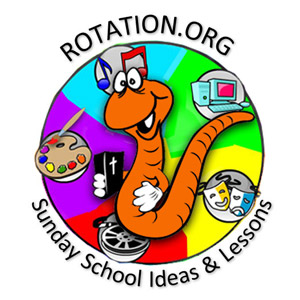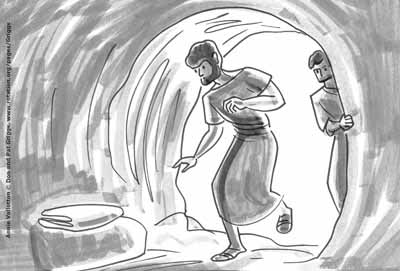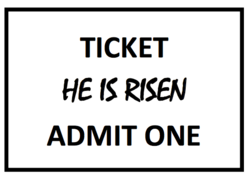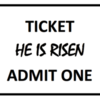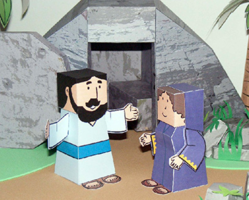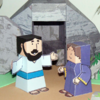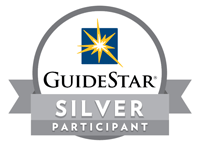Easter
Video Workshop
Summary of Lesson Activities:
Watch a clip from “The Visual Bible—Matthew”. Create scenes from felt figures and/or objects cut out of cardstock and project them using an overhead projector.
Scripture Reference:
Begins at Matthew 27:57.
Leader Preparation:
Materials List:
- Bibles
- DVD: “The Visual Bible: Matthew"
- DVD player
- TV or projector
- Overhead Projector
- Felt Figures (optional)
- Cardstock
- Scissors
- Pencils
- Transparency sheets – one for each scene
- Markers that will write on transparencies (wipe off markers will allow you to reuse the sheets
- Screen or whiteboard to shine the transparencies on to
- A simple shape cut out of cardstock (to use for demonstration)
- Camera (optional)
Lesson Plan
Opening:
Greet the children and Introduce yourself and any helpers that you have.
Dig:
Important Note for Video Station Teachers:
With video, we are tapping into the brain's love of media to teach God's Word and improve the brain's ability to recall it and embrace it. It should not just be passive “sitting and watching”—we are engaging the kids with the video. The “Pause” feature on the video player is a great tool for stopping and asking questions in a way that will definitely get their attention (instead of trying to talk 'over' the video). Say thinkgs like did you notice such and such—what would you do—what do you think will happen next, etc. Don't be afraid to view an important scene a second time (if time permits).
Before the video begins, assign them things to look for. You might want to hand out paper and pencil to help out in this. After the video, debrief and process the story: What did you see? What happened? Did anyone notice ___? What was the reaction of ___ to ___? What would have been your response?
Familiarize yourself with the video before the day of class. Before class starts, make sure that you understand how the equipment operates. Load your video and get it to the starting point mentioned in the lesson. Some videos may take some liberties with the story-you may need to point out these discrepancies.
Introduction & Bible Story:
Please make sure that the students hear and “get” the Bible story as well as the application of that story to their lives. The Bible story is the MOST important part of the lesson—it is much more important than the activity associated with this station!
Briefly review the events of Holy Week (see Bible Background). The students studied the Last Supper in the previous rotation, and are reviewing the events of Holy Week in another station.
Say: In this rotation, we are going to focus on what happened after Jesus died for our sins on the cross. We will be watching a video called “The Visual Bible”. The Bible is acted out word for word. There is one section where Matthew (the author of this Gospel) is shown telling part of the story to 2 other people. I want you to open your Bibles to Matthew 27: 57. This is where the video will be starting.
Questions: Ask a few questions about the Bible story. You can ask
- Factual questions (Who, What, When, Where, etc)
- Why questions (Why did they do this, why did this happen, etc)
- What do you think or feel about what happened?
- Application questions—some examples (How were their lives different because….. and how would your life be different; Was……..different or harder in Bible times than it would be now; what would this look like today; how could you……….)
Activities:
Video
See Advance Preparation for where you should have the DVD cued. You will be showing the video and pausing it to ask questions (see lesson below for those prompts). The video clip—without pausing—is about 6 minutes.
Say: We are starting the story at the point where Jesus has just died, and His friends are taking His body down from the cross. There is more than one cross, because Jesus was crucified along with two thieves. As we start watching, take note of a few things: Who was there? Who was not there? What kind of a man was Joseph of Arimathea?
Start the video at Matthew 27:57 (timestamp of 2:07:33). Pause at time stamp 2:08:35 (Pilate is coming down the stairs).
Ask: Who was there? (Joseph of Arimathea, the two Marys) Who was not there? (Jesus’ disciples—John was the only disciple there at the crucifixion; the others were afraid and in hiding. Isn’t it amazing how they went from being so afraid to being so bold in preaching about Jesus once they had been filled with the Holy Spirit at Pentecost!) What kind of a man was Joseph? (rich man)
I am going to read you a verse from the book of the prophet Isaiah—he was talking about very specific things about the death of the Savior hundreds of years before it happened. Read Isaiah 53:9—“He was assigned a grave with the wicked, and with the rich in his death, though he had done no violence nor was any deceit in his mouth”. So, he died with the wicked (two thieves were crucified with him) and was with the rich in his death (Joseph of Arimathea, a wealthy man, provided Jesus with his own tomb) and he was put to death even though he had done no violence or deceit (Jesus was innocent but died for OUR sins).
Resume the video. Pause at timestamp 2:09:14 (after the quote “last deception will be worse than the first)
Ask: What are the chief priests and Pharisees worried about? (disciples will steal the body of Jesus) They remembered hearing Jesus talk about rising again after 3 days. Jesus had been talking about the Old Testament prophet Jonah—what do you remember about him? (swallowed by a big fish). In Matthew 12: 40, Jesus says “For as Jonah was three days and three nights in the belly of a huge fish, so the Son of Man will be three days and three nights in the heart of the earth.”
Resume the video. Pause at timestamp 2:09:45 (after the quote “posting the guard” and right before you see the women on the road).
Ask: So Pilate said that they could post a guard. Do you think that they checked to make sure that the body of Jesus was IN the tomb before they sealed it up? (Yes) How are the priests and Pharisees feeling at this point? (pleased that the disciples won’t be able to play any tricks)
Resume the video. Pause at timestamp 2:11:13 (ends with Matthew saying “Now I have told you)
Say: The angel said “He is not here; he has risen, just as he said.” In Matthew 16:21, Jesus tells his disciples that he must be killed and on the third day be raised to life. And now it has happened! The angel tells the women to “see the place where he lay”. What did they see—or not see—when they looked? (Jesus was not there).
Resume the video. Pause at timestamp 2:11:45 (Jesus is walking away)
Ask: Is says that the women clasped—or grabbed onto—Jesus’ feet. What does that tell you about Jesus’ body? (he was real, not a ghost) What was the reaction of the women—what do you think they were feeling? What was the reaction of Jesus—what do you think He was feeling?
Resume the video. Pause at timestamp 2:13:46 (after the quote: “to this very day)
Ask: The guards come to report that the body of Jesus is missing. The chief priests KNOW that Jesus’ body is gone—they just don’t want to admit that He actually rose from the dead. So, the chief priests gave the guards a large sum of money. They were bribing the guards. What did they want the guards to say? (the disciples stole the body while we were asleep) The disciples would have to walk around the guards in the dark and then move a big heavy stone. Would they have been able to do that without waking the guards? (no) If the disciples HAD come in the middle of the night, what would the guards have done? (fought them off, arrested them) So, would the guards be telling the truth? (no) So, why wasn’t Jesus’ body in the tomb? (He has risen from the dead!)
Overhead Projector Storytelling
Now we are going to create some scenes from the Bible story, using the overhead projector. Turn on the projector, put the shape on the screen, and show the students how a black and white silhouette appears. First, we will come up with some different scenes. Then I will assign a few students to each scene. You will cut shapes out of the paper and use them to create a scene. You don’t need to color on the paper—that won’t show up. You can use the markers to write words on the clear plastic sheets if you need to (or the teacher can write the words for the younger students).
Brainstorm some different ideas for scenes with the students (the number of scenes that you pick might be dictated by how many student teams that you will have). Some ideas for scenes are:
- Jesus Dies
- Jesus is Buried
- Pharisees Meet with Pilate
- Guards at the Tomb
- Angel and Women at the Tomb
- Jesus and the Women
- Guards and the Priests
Divide the children up into groups—assigning a scene to each group. Give them about 5 minutes to come up with their scene and cut out the shapes. If you are using the felt figures, let them see the selection. More than one group may want to use figures in their scene, so they will need to share.
Have each group come up to the overhead projector to create their scene using the cutouts, felt figures, markers. They should move quickly—each scene should take a minute or less (so they won’t be able to do A LOT of drawing/writing).
Discuss each scene: What is happening? What are the characters feeling? How can that be shown on the screen? Repeat with each scene. If you have a camera—take a picture of each scene.
Reflection:
If someone asks why you believe that Jesus is truly risen from the dead, what can you say to them?
Close with a prayer.
Age Adaptations:
Younger students: You may want to have more preformed shapes for them to use in the overhead projector section. You may need to do any writing for them.
Resources/Bibliography:
Derden, Jaymie. Overhead Projector Storytelling, Parable of the Lost Sheep.
A lesson written by Cathy Walz
A representative of Rotation.org reformatted this post to improve readability.
